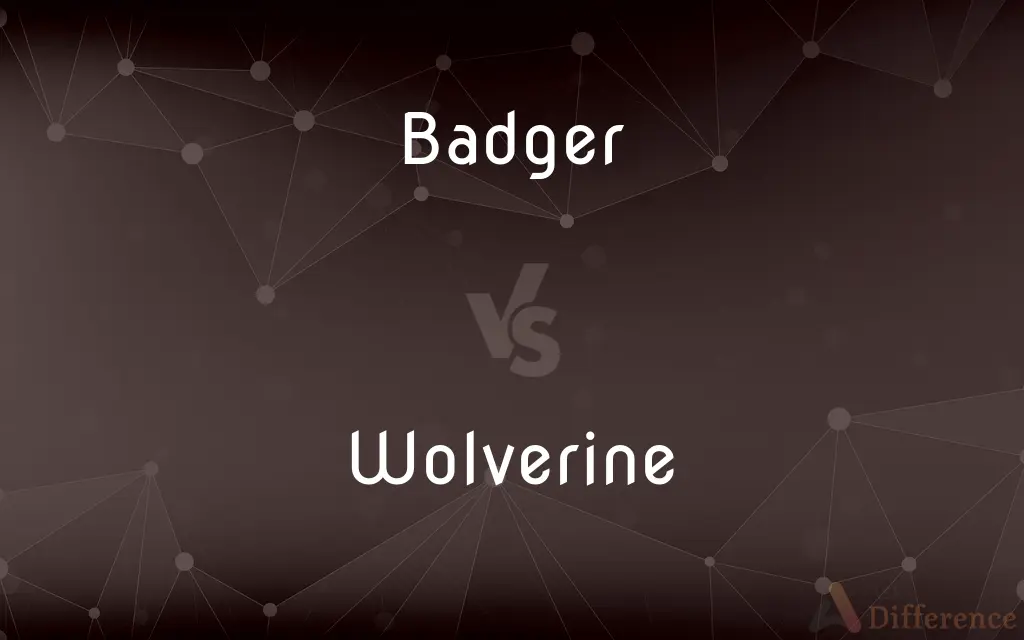Badger vs. Wolverine — What's the Difference?
By Tayyaba Rehman — Updated on October 27, 2023
A badger is a burrowing mammal known for its black and white face, while a wolverine is a larger, ferocious carnivore resembling a small bear. Both are part of the Mustelidae family but differ in size, habitat, and behavior.

Difference Between Badger and Wolverine
Table of Contents
ADVERTISEMENT
Key Differences
Badger is a term that generally refers to several species of burrowing mammals known for their broad bodies and distinctive black and white face patterns. On the other hand, the wolverine is a specific animal, often referred to as "Gulo gulo," known for its stocky build and ferocious nature.
While both badgers and wolverines belong to the Mustelidae family, their habitats vary widely. Badgers are usually found in open plains and prairies, where they dig burrows, while wolverines inhabit cold northern boreal forests and tundras, often traveling vast distances in search of food.
In terms of size and appearance, badgers are generally smaller, with some species having long claws used for digging. Wolverines, in contrast, are larger and have a more bear-like appearance, with powerful jaws and sharp claws suited for hunting and scavenging.
The diet of a badger is varied, including worms, insects, and small mammals. Wolverines, however, are more carnivorous, preying on animals like deer, rodents, and even carrion.
Behaviorally, badgers are known to be solitary creatures, fiercely defending their territory, especially during mating season. Wolverines are also solitary and have a reputation for their strength and fearlessness, often taking on animals much larger than themselves.
ADVERTISEMENT
Comparison Chart
Scientific Classification
Belongs to multiple species.
Specifically "Gulo gulo."
Habitat
Open plains and prairies.
Northern boreal forests and tundras.
Size and Appearance
Smaller, with distinct face patterns.
Larger, bear-like appearance.
Diet
Worms, insects, small mammals.
Primarily carnivorous, including deer and rodents.
Behavior
Solitary, territorial.
Solitary, fearless, strong predator.
Compare with Definitions
Badger
A burrowing mammal with a black and white face.
The badger emerged from its burrow at dusk.
Wolverine
A member of the Mustelidae family native to cold regions.
The wolverine roams the frozen tundras of the North.
Badger
A creature with a broad body and short legs.
The badger waddled across the meadow.
Wolverine
A ferocious carnivore resembling a small bear.
The wolverine is known for its incredible strength.
Badger
A member of the Mustelidae family known for digging.
The badger's long claws are perfect for digging.
Wolverine
An animal with a reputation for fearlessness.
The wolverine can take on prey much larger than itself.
Badger
Badgers are short-legged omnivores mostly in the family Mustelidae (which also includes the otters, polecats, weasels, and ferrets), but also with two species called "badgers" in the related family Mephitidae (which also includes the skunks). Badgers are a polyphyletic grouping, and are not a natural taxonomic grouping: badgers are united by their squat bodies, adapted for fossorial activity.
Wolverine
A stocky predator with sharp claws and powerful jaws.
With its powerful jaws, the wolverine can crush bones easily.
Badger
Any of several carnivorous burrowing mammals of the family Mustelidae, such as Meles meles of Eurasia or Taxidea taxus of North America, having short legs, long claws on the front feet, and a heavy grizzled coat.
Wolverine
A solitary creature that often travels vast distances.
The wolverine is known to travel great distances in search of food.
Badger
The fur or hair of any of these mammals.
Wolverine
The wolverine () (also spelled wolverene), Gulo gulo (Gulo is Latin for "glutton"), also referred to as the glutton, carcajou, or quickhatch (from East Cree, kwiihkwahaacheew), is the largest land-dwelling species of the family Mustelidae. It is a muscular carnivore and a solitary animal.
Badger
Any of several similar mammals, such as the ratel.
Wolverine
A solitary mustelid mammal (Gulo gulo) of northern regions, having a heavyset body, short legs, dark fur, and a bushy tail, and known for its aggressive predatory behavior. Also called carcajou, glutton, skunk bear.
Badger
To ask or nag (someone) about something in an annoying and persistent way; pester
Badgered the boy into cleaning his room.
Wolverine
A solitary, fierce mammal of the Mustelidae family, species.
Badger
Any mammal of three subfamilies, which belong to the family Mustelidae: Melinae (Eurasian badgers), Mellivorinae (ratel or honey badger), and Taxideinae (American badger).
Wolverine
A resident of Michigan
Badger
A native or resident of the American state, Wisconsin.
Wolverine
Wolverine of northern Eurasia
Badger
(obsolete) A brush made of badger hair.
Wolverine
Stocky shaggy-coated North American carnivorous mammal
Badger
A crew of desperate villains who robbed near rivers, into which they threw the bodies of those they murdered.
Badger
(obsolete) An itinerant licensed dealer in commodities used for food; a hawker; a huckster; -- formerly applied especially to one who bought grain in one place and sold it in another.
Badger
To pester; to annoy persistently; to press.
He kept badgering her about her bad habits.
Badger
An itinerant licensed dealer in commodities used for food; a hawker; a huckster; - formerly applied especially to one who bought grain in one place and sold it in another.
Badger
A carnivorous quadruped of the genus Meles or of an allied genus. It is a burrowing animal, with short, thick legs, and long claws on the fore feet. One species (Meles meles or Meles vulgaris), called also brock, inhabits the north of Europe and Asia; another species (Taxidea taxus or Taxidea Americana or Taxidea Labradorica) inhabits the northern parts of North America. See Teledu.
Badger
A brush made of badgers' hair, used by artists.
Badger
To tease or annoy, as a badger when baited; to worry or irritate persistently.
Badger
To beat down; to cheapen; to barter; to bargain.
Badger
Sturdy carnivorous burrowing mammal with strong claws widely distributed in the northern hemisphere
Badger
Annoy persistently;
The children teased the boy because of his stammer
Badger
Persuade through constant efforts
Badger
An animal characterized by nocturnal habits.
Badgers are most active during the night.
Badger
A mammal often found in open grasslands.
The open prairie is a common habitat for the badger.
Common Curiosities
Where can you find badgers?
In open plains, prairies, and sometimes woodlands.
Where do wolverines live?
In northern boreal forests and tundras.
What is a badger?
A burrowing mammal known for its distinctive face patterns.
Are badgers and wolverines related?
Yes, both belong to the Mustelidae family.
What is a wolverine?
A ferocious carnivore resembling a small bear, native to cold regions.
Which is bigger, a badger or a wolverine?
A wolverine is typically larger.
What do badgers eat?
They have a varied diet, including worms, insects, and small mammals.
Are badgers aggressive?
They can be territorial, especially during mating seasons.
Do wolverines hibernate?
No, they remain active throughout the winter.
What do wolverines eat?
They are carnivorous, eating animals like deer, rodents, and carrion.
Why are wolverines considered fearless?
They have a reputation for taking on animals much larger than themselves.
Is the wolverine endangered?
Their populations are decreasing in some areas due to habitat loss and human activities.
Can both badgers and wolverines be found in North America?
Yes, both have populations in various parts of North America.
How do badgers defend themselves?
They have strong jaws, sharp claws, and can dig quickly to escape predators.
How many species of badgers are there?
There are several species across different continents.
Share Your Discovery

Previous Comparison
Pacu vs. Piranha
Next Comparison
Entrepreneurship vs. ManagementAuthor Spotlight
Written by
Tayyaba RehmanTayyaba Rehman is a distinguished writer, currently serving as a primary contributor to askdifference.com. As a researcher in semantics and etymology, Tayyaba's passion for the complexity of languages and their distinctions has found a perfect home on the platform. Tayyaba delves into the intricacies of language, distinguishing between commonly confused words and phrases, thereby providing clarity for readers worldwide.














































